792
About caviar
Source: the-fencer
Hello boys and girls! In the next issue of air seafood guide, dedicated to the red caviar. I must say that this topic is extremely turbid even for experts, therefore, we are with you Let us examine the main points, knowing that you will be able to live a little longer.
Since you are so smart that reading this magazine, you know what fraud is flourishing in the shrimp market. So: eggs a much more expensive product, and therefore the fraud on the market at times steeper and more refined. So open your eyes shall be entered in the post favorites furiously share this information with your friends.
Today we tear away the veils.
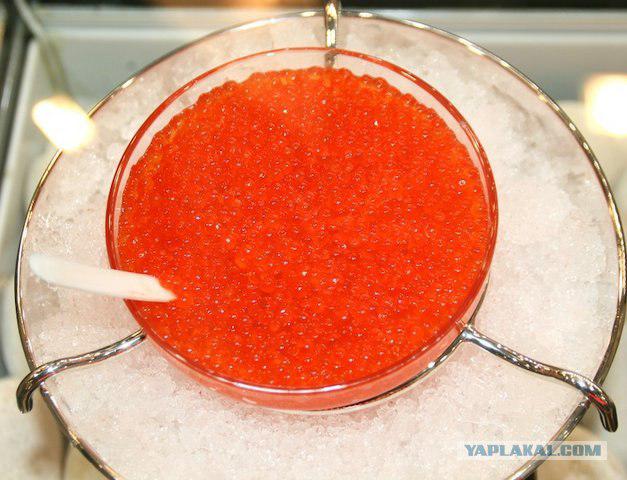
I repeat: red caviar - an expensive product. So take it for granted that I have repeated many times: the more expensive the product, so it is (usually) better. Cheap product is not likely to be helpful, but on the contrary can be harmful.
Red caviar can be of different types and different grades. Sometimes trout roe (trout farm), pink salmon caviar, caviar chum, sockeye salmon caviar, caviar chinook. Each grade caviar can vary greatly in quality.
How quickly at a glance to distinguish good from bad eggs? Very simple. Buy a jar of caviar (it is usually sold in a tin). Open and turn over the table. Good eggs will remain in the bank, a bad fall out.
What determines the quality of the caviar?
First of all how quickly the fish caviar was delivered to the processing plant. As soon as the fish dies, her body will inevitably begin the processes of decomposition, affects the calf. Quickly delivered to the factory the fish is elastic, dry eggs, which breaks (exempt from yastiks) manually (or automatically) to grohotke:
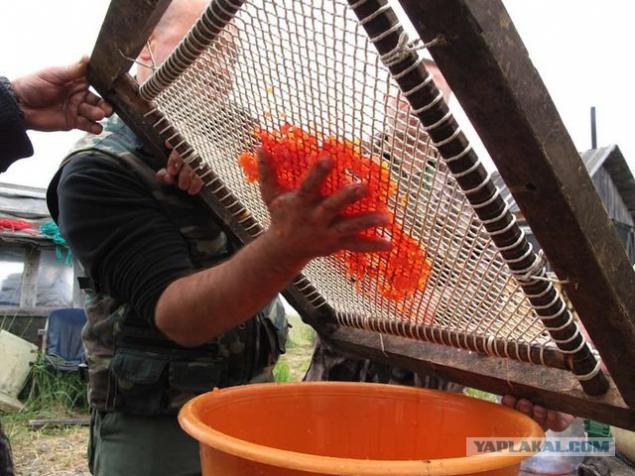
This caviar is the most expensive, and it is more or less clear. It is dry and free of excess moisture, it looks something like this:
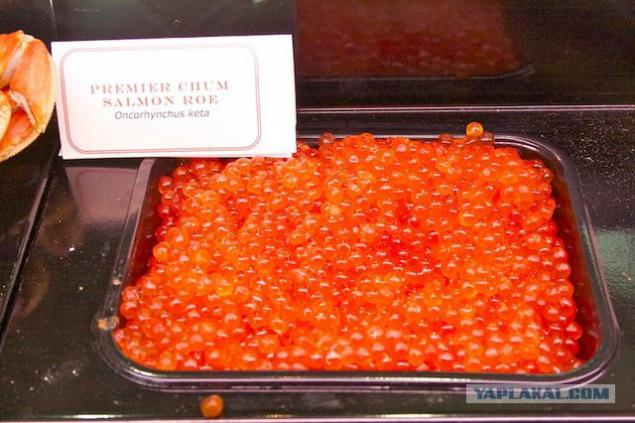
Then begins the technology. The longer the fish spent in the way to the processing plant (the majority of which are located on the coast, far from the places of fishing), the worse the quality of raw materials. Sometimes the fish spends in transit (already dead) to two or three days. At the time of delivery to the factory such caviar is not suitable for punching through and from yastiks grohotku it free using a special "enzimovoy" technology.
It looks something like this caviar:

As you can see, a lot of eggs is exhausted, leading to the appearance of the liquid in the calf. This is a direct indicator of lower quality.
But it's flowers. This is only a raw material, which is to go all the way from the factory to the banks lying on the counter of your supermarket. And this is where the fun begins.
With a good product khimichit makes no sense: only the spoil. But with caviar enzimovoy khimichit quite a sense it is. An avid Russian-Ukrainian producer of canned beer adds spawn different stuff, such as: refined sunflower oil to increase the percentage of output and reduce prices accordingly.
But in addition to oil, as a preservative in caviar added sorbic acid, and (even worse) - methenamine.
Urotropin is a powerful antiseptic preparation, preserving at the same time killing the eggs and fuck all of your stomach flora. If you bought caviar bitter language - it just is methenamine. God forbid you give this spawn children!
Among other things, methenamine is a strong allergen and banned as a food additive in Europe (and even like as in Russia), but in Ukraine it is still used. I even know what manufacturers are doing, but will not speak. It is enough that I have already told you: to spread information and learn to think for themselves.
Let us examine the main types of caviar.
1. Caviar trout (small grains).

About this caviar is worth mentioning separately. Trout, which is used for the production of eggs, grown on farms in Denmark. At baseline, this high-quality caviar is the most of all, because refineries are located in the immediate vicinity of farms, Abraham (as in Alaska at the time of mass fishing) at such plants does not happen. Also (this is an additional plus), this caviar is often used for the production of Japanese products "sudzhiko" (about it I'll somehow separately).
Photos of the second or third grade I have not. And I'm not even sure what those are.

2. Gorbuscha:
Class:
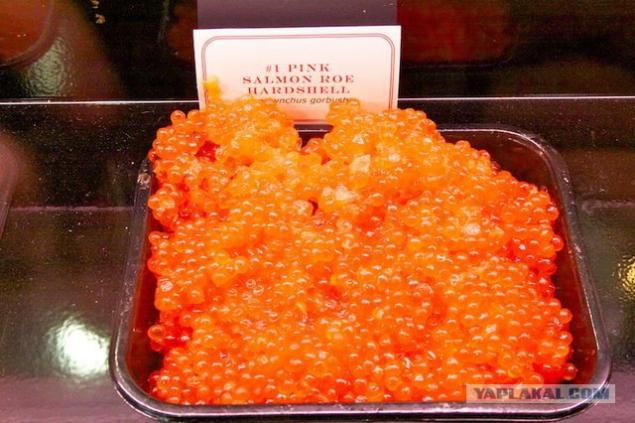
Class II:
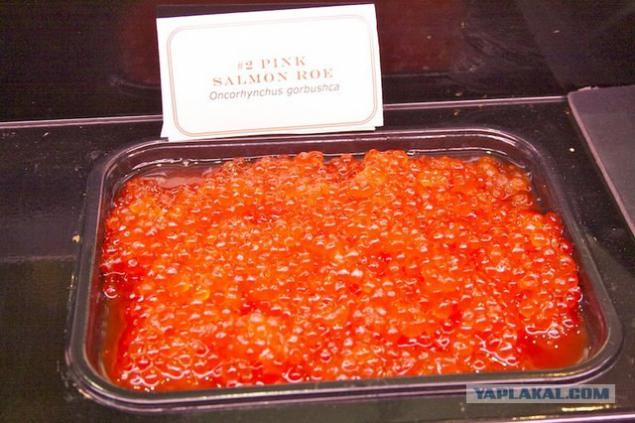
Enzimovaya Gorbuscha:

3. caviar chum:
Class:

Class II:
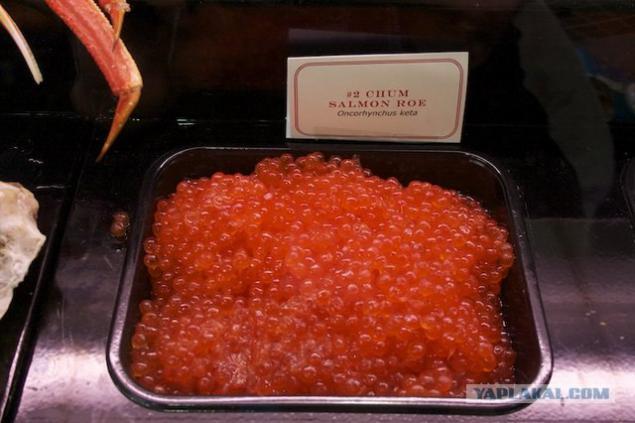
Third grade:
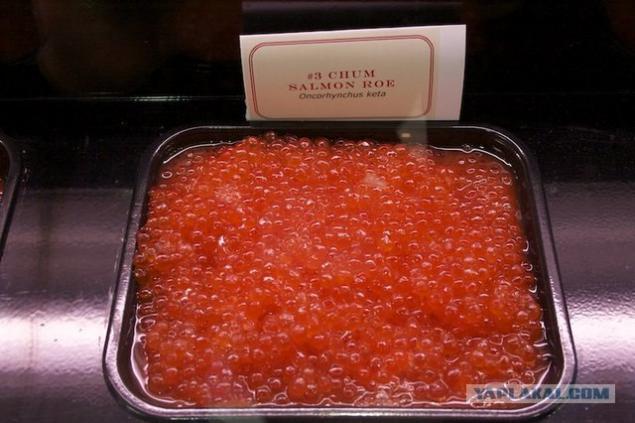
As of the most common species of sockeye salmon eggs there. It is very similar to trout eggs (small grain) and photos at hand I have.
Advice on buying calves:
1. Try to buy eggs in a package of a kilogram or half a kilo. It looks like this:
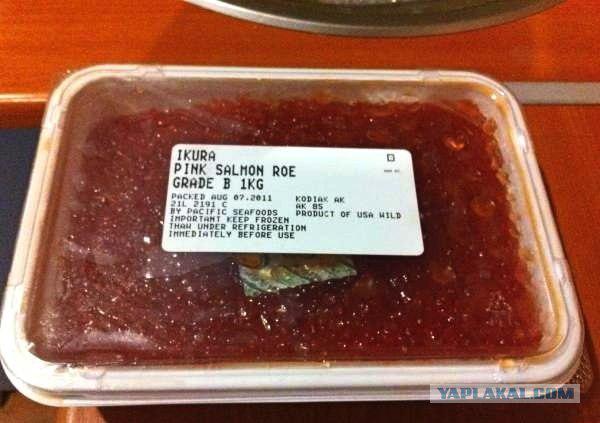
This - the raw material. As such, the eggs produced in factories in the United States, in this form it is brought to Russia and Ukraine, of such containers and it gets to the banks that are in your supermarket. This caviar can be first, second or third grade (the more the better), but it definitely will not be any vegetable oil or sorbic acid, or hexamine.
And on such container is written that lies inside of caviar (salmon, chum, sockeye salmon, trout, etc.).
2. If you do decide to buy the bank - pay attention to the following things:
a) the bank shall be designated type of caviar (salmon, sockeye, chum, etc.). If on the bank simply says "red caviar" - is almost guaranteed to be in some kind of rubbish is not the first freshness.
b) eggs in the pot should be dry and not fall out when you turn the jar.
c) caviar God forbid should not taste bitter.
d) subject to the three conditions listed above, such eggs can not be cheap. According to my observations, a good bank-ounce eggs in the supermarket is ten dollars.
3. Do not get fooled by the "Far East" brand. The myth that only the Far East roe caviar have true-and all the rest - sucks, came to us from the scoop. Firstly it is a delusion. Second - in the majority of "Far East" brand (such as "Taste of Kamchatka", etc.) is caviar, produced in the United States.
I'm not saying that the Far East is bad eggs. I say: learn to think with your head. In the Far East is elementary enough product. Far East is simply not able to cover all the needs of even one of the Russian market, which is not surprising: no facilities, no infrastructure (say thank you kindly uncle Pu stable oil for years, during which successfully pissed away all polymers).
If so you want to support domestic producers and hate America - see where caviar is produced. Unless Kamchatka but somewhere in Moscow or Kiev region - lies in the same America. Do not hesitate.
Generally (in my opinion) do not trust the Russian-Ukrainian brands (except for those that are produced in Kamchatka). For at least strange trusted manufacturer who owns the raw material for production. And given the fact that each year varies considerably, not only the quality but also the price of raw materials (one and a half to two times), then the next year (or even next month, if the contract with supermarket signed and fit Raw ended) in the same bank may be completely different eggs.
Source:
Hello boys and girls! In the next issue of air seafood guide, dedicated to the red caviar. I must say that this topic is extremely turbid even for experts, therefore, we are with you Let us examine the main points, knowing that you will be able to live a little longer.
Since you are so smart that reading this magazine, you know what fraud is flourishing in the shrimp market. So: eggs a much more expensive product, and therefore the fraud on the market at times steeper and more refined. So open your eyes shall be entered in the post favorites furiously share this information with your friends.
Today we tear away the veils.

I repeat: red caviar - an expensive product. So take it for granted that I have repeated many times: the more expensive the product, so it is (usually) better. Cheap product is not likely to be helpful, but on the contrary can be harmful.
Red caviar can be of different types and different grades. Sometimes trout roe (trout farm), pink salmon caviar, caviar chum, sockeye salmon caviar, caviar chinook. Each grade caviar can vary greatly in quality.
How quickly at a glance to distinguish good from bad eggs? Very simple. Buy a jar of caviar (it is usually sold in a tin). Open and turn over the table. Good eggs will remain in the bank, a bad fall out.
What determines the quality of the caviar?
First of all how quickly the fish caviar was delivered to the processing plant. As soon as the fish dies, her body will inevitably begin the processes of decomposition, affects the calf. Quickly delivered to the factory the fish is elastic, dry eggs, which breaks (exempt from yastiks) manually (or automatically) to grohotke:

This caviar is the most expensive, and it is more or less clear. It is dry and free of excess moisture, it looks something like this:

Then begins the technology. The longer the fish spent in the way to the processing plant (the majority of which are located on the coast, far from the places of fishing), the worse the quality of raw materials. Sometimes the fish spends in transit (already dead) to two or three days. At the time of delivery to the factory such caviar is not suitable for punching through and from yastiks grohotku it free using a special "enzimovoy" technology.
It looks something like this caviar:

As you can see, a lot of eggs is exhausted, leading to the appearance of the liquid in the calf. This is a direct indicator of lower quality.
But it's flowers. This is only a raw material, which is to go all the way from the factory to the banks lying on the counter of your supermarket. And this is where the fun begins.
With a good product khimichit makes no sense: only the spoil. But with caviar enzimovoy khimichit quite a sense it is. An avid Russian-Ukrainian producer of canned beer adds spawn different stuff, such as: refined sunflower oil to increase the percentage of output and reduce prices accordingly.
But in addition to oil, as a preservative in caviar added sorbic acid, and (even worse) - methenamine.
Urotropin is a powerful antiseptic preparation, preserving at the same time killing the eggs and fuck all of your stomach flora. If you bought caviar bitter language - it just is methenamine. God forbid you give this spawn children!
Among other things, methenamine is a strong allergen and banned as a food additive in Europe (and even like as in Russia), but in Ukraine it is still used. I even know what manufacturers are doing, but will not speak. It is enough that I have already told you: to spread information and learn to think for themselves.
Let us examine the main types of caviar.
1. Caviar trout (small grains).

About this caviar is worth mentioning separately. Trout, which is used for the production of eggs, grown on farms in Denmark. At baseline, this high-quality caviar is the most of all, because refineries are located in the immediate vicinity of farms, Abraham (as in Alaska at the time of mass fishing) at such plants does not happen. Also (this is an additional plus), this caviar is often used for the production of Japanese products "sudzhiko" (about it I'll somehow separately).
Photos of the second or third grade I have not. And I'm not even sure what those are.

2. Gorbuscha:
Class:

Class II:

Enzimovaya Gorbuscha:

3. caviar chum:
Class:

Class II:

Third grade:

As of the most common species of sockeye salmon eggs there. It is very similar to trout eggs (small grain) and photos at hand I have.
Advice on buying calves:
1. Try to buy eggs in a package of a kilogram or half a kilo. It looks like this:

This - the raw material. As such, the eggs produced in factories in the United States, in this form it is brought to Russia and Ukraine, of such containers and it gets to the banks that are in your supermarket. This caviar can be first, second or third grade (the more the better), but it definitely will not be any vegetable oil or sorbic acid, or hexamine.
And on such container is written that lies inside of caviar (salmon, chum, sockeye salmon, trout, etc.).
2. If you do decide to buy the bank - pay attention to the following things:
a) the bank shall be designated type of caviar (salmon, sockeye, chum, etc.). If on the bank simply says "red caviar" - is almost guaranteed to be in some kind of rubbish is not the first freshness.
b) eggs in the pot should be dry and not fall out when you turn the jar.
c) caviar God forbid should not taste bitter.
d) subject to the three conditions listed above, such eggs can not be cheap. According to my observations, a good bank-ounce eggs in the supermarket is ten dollars.
3. Do not get fooled by the "Far East" brand. The myth that only the Far East roe caviar have true-and all the rest - sucks, came to us from the scoop. Firstly it is a delusion. Second - in the majority of "Far East" brand (such as "Taste of Kamchatka", etc.) is caviar, produced in the United States.
I'm not saying that the Far East is bad eggs. I say: learn to think with your head. In the Far East is elementary enough product. Far East is simply not able to cover all the needs of even one of the Russian market, which is not surprising: no facilities, no infrastructure (say thank you kindly uncle Pu stable oil for years, during which successfully pissed away all polymers).
If so you want to support domestic producers and hate America - see where caviar is produced. Unless Kamchatka but somewhere in Moscow or Kiev region - lies in the same America. Do not hesitate.
Generally (in my opinion) do not trust the Russian-Ukrainian brands (except for those that are produced in Kamchatka). For at least strange trusted manufacturer who owns the raw material for production. And given the fact that each year varies considerably, not only the quality but also the price of raw materials (one and a half to two times), then the next year (or even next month, if the contract with supermarket signed and fit Raw ended) in the same bank may be completely different eggs.
Source:























